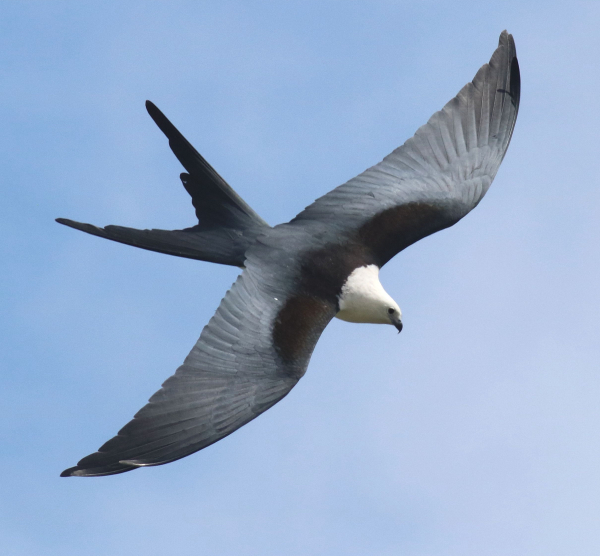
Kites, like this Swallow-tailed Kite have been among the first birds of prey to migrate south en masse. You can monitor daily totals at raptor count sites at the HawkWatch website (photo by Paul Konrad).
|
Throughout the fall migration period, now through November, you can monitor numbers of birds of prey migrating above raptor count sites across North America. In some cases you can see live updates of the number of eagles, falcons, hawks, and kites being seen, all provided at the HawkCount website, operated by the Hawk Migration Association of North America’s (HMANA). It’s also possible to see totals for each month, and to compare numbers with past years’ count totals. Even now, on peak days hundreds of raptors are being counted – even thousands!
That’s right, kite migration is showing surges of migration as evidenced by a high count of 2,149 Mississippi Kites at the Corpus Christi HawkWatch last Friday, August 30th, followed by 4,208 the following day, and more than 14,000 during the month of August. There are a few Swallow-tailed Kites passing by Corpus Christi too, but during peak days at the Florida Keys HawkWatch as many as 1,335 Swallow-tailed Kites were counted, along with a variety of other raptors. Look farther south to Panama, and we see that Monday’s totals included a monumental 19,917 Mississippi Kites and 775 Swallow-tailed Kites with 115 Plumbeous Kites passing by Bocas Valle de Agua – Viva Panama!
Northern raptor counting sites are also seeing good numbers of early migrants, for example: Hawk Ridge at Duluth, Minnesota, where Sunday’s count included 103 Bald Eagles, 115 Sharp-shinned Hawks, 214 Broad-winged Hawks, and 51 Red-tailed Hawks among a variety of raptors. On Monday, Hawk Cliff Hawkwatch in southern Ontario tallied 584 Broad-winged Hawks, 125 American Kestrels, 77 Sharp-shinned Hawks, and 26 Northern Harriers; plus biologists at Cape May, New Jersey counted 451 American Kestrels, 17 Merlins, and 182 Osprey passing by on Labor Day. Many raptor count sites also keep counts of other migrating birds, ranging from songbirds to shorebirds and even seabirds.
Each species has peak migration periods and you can see numbers rise and peak simply by checking monthly totals – just click on the hawkwatch site of interest, then click on the word “Monthly” in the left margin of each hawkwatch webpage (you can also change the Month to August, and click on “Go” to get an overview to date). Check in periodically to monitor fall raptor migration at HawkCount and make a plan to visit a raptor counting station this fall – you will surely enjoy the experience!